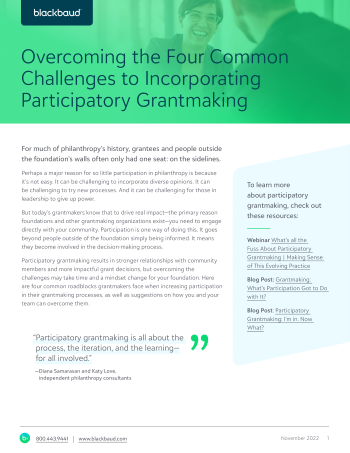Facilitation: The Secret Ingredient for Successful Participatory Decision-Making in Philanthropy

Raise your hand if you’ve ever had a bad experience working with a group of people to make a decision. Most of us have. Maybe it was a work task force, a school committee, or family members. And things go wrong: roles aren’t clear, timelines extend, or people disagree.
Most groups of people do not self-manage well. Group decision-making is especially fraught, perhaps because it brings up issues of power and control. It often takes clarity of roles and purview and even some structure to do that.
In our years of talking to staff, boards, and communities about participatory philanthropy, people often talk about their worst participatory decision-making experiences. That emerges as a reason for foundation leadership to avoid working with a group of people, especially outside of the hierarchy of control that the foundation has with its own staff.
However, we feel strongly that this is the wrong conclusion to draw. Group decision-making doesn’t have to be a difficult, long, and painful experience. It may instead be that something—or rather, someone—is missing from the process.
New to Participatory Grantmaking? Check out the blog post Grantmaking: What’s Participation Got to Do with It?
Facilitation: The Secret Sauce of Participatory Processes
Especially when it comes to participatory decision-making, we believe that a skilled facilitator is essential.
The role of strategic facilitation of decision-making in participatory philanthropy is often unrecognized and underappreciated.
Why? Facilitators have many superpowers, and like superheroes, many of those powers may be invisible to others. These include so-called “soft skills” that are process-oriented; they serve to bring people together in meaningful ways, connect people to their own expertise and to each other, hold space for change, and more. But these “soft skills” are not magic. They are often accompanied by tried-and-true strategies.
Facilitation: Not Merely an Art
Facilitators know how to support a group to come up with shared agreements for engaging, and how to help them stay true to those agreements. They work to create room for differences of opinion and even conflict. They know when to be playful and when to ask the group to pause. These facilitators identify bias and skillfully call the group’s attention to it. They know how to create inclusive and accessible environments that honor everyone’s participation needs. They also tap into the arts – and connections to our bodies and the natural world—to spark transformative and generative spaces.
There is a large and diverse toolkit that skilled facilitators use to address every stage of a participatory decision-making process, from preparation to discussion to communicating decisions to stakeholders. Let’s face it—high-stakes meetings where decisions will be made require preparation.
As facilitators, here are some areas we focus on in preparation:
- Sharing goals: All participants should be clear on the goal of their time together: what is expected and what outcome they are working towards. This is the case whether the focus is eligibility criteria for applicants, determination of a slate of grants, or input into grantmaking strategy. Without knowing why coming together is important, meetings can go astray, people can get frustrated, and trust can be lost.
- What’s on the table: Participants will be most effective if they share an understanding for what they are deciding. There is nothing more frustrating than working hard to make decisions and then being told that your decisions cannot be implemented. Facilitators of participatory processes need to make sure that any red lines around grantmaking are defined and their rationale communicated in advance of decision-making. These might include specific geographies a foundation has committed to and will not shift, required Board approval of grants, or funding that is restricted to non-profits with a 501(c)3 equivalency.
- Ensuring motivation: Participants join for different reasons, and a facilitator should understand individual motivations and what matters to each participant. That can help the facilitator ensure that the experience is meaningful. Skilled facilitators consider how to recognize and appreciate participants. This might include adequate financial compensation, networking and relationship-building opportunities, or recognition for their participation that will help them in other spheres of their lives.
During the group’s decision-making phase, a skilled facilitator turns their attention to:
- Offering shared agreements: Shared agreements about how the group will work together should be informed by any existing values the foundation or group has. It’s key that participants understand what these ways of working mean and have a chance to practice them. Participants should be clear if there is any expectation of confidentiality and attribution. Agreements should be regularly revisited.
- Ensuring inclusion and accessibility: Not everyone participates in the same way. A skilled facilitator uses multiple, accessible methods so everyone feels comfortable expressing their opinions. This might include sharing a presentation in advance so people with learning or visual impairments have time for review. It might mean frequent breaks so those who cannot sit or participate for long periods of time feel considered.
- Creating space for divergent thinking and conflict: The idea of participatory processes is that decisions will be better if people who have a stake in them are involved. A facilitator should plan for divergent thinking. Skilled facilitators work towards supporting dissenting voices, ensuring participants understand different viewpoints. In addition, skilled facilitators are ready to support conflict and address micro or macro aggressions, especially when they occur towards people with marginalized identities.
- Offering diverse methodologies: A facilitator works to bring in the voices of all participants, and to do so, can use different methodologies like individual reflections, small groups or pairings, a fishbowl, or world café. A facilitator can tap into creativity, like music, poetry, visual arts, or even meditation. A skilled facilitator is also looking to ensure participants really listen to others.
- Structuring how decisions will be made: A facilitator should have a good understanding of how the group will decide. There are many ways that groups can come to a decision, including voting, delegating decisions to a person or subgroup, and hierarchical/top down. In participatory processes, our preferred way of decision making is consensus. When decisions are made, all participants should be clear about what that decision is—ideally it will be recorded in a place all can refer to.
For participatory grantmaking, where people with lived experience make decisions, we generally recommend consensus decision making. Consensus decision making ensures everyone is involved and heard in a decision, and is trying to work collaboratively to reach a solution. Consensus increases the chance that those who are at the margin have influence over the final outcome, and is a more cooperative rather than adversarial approach. According to Seeds for Change, “Consensus decision making is a creative and dynamic way of reaching agreement in a group. Instead of simply voting for an item and having the majority getting their way, a consensus group is committed to finding solutions that everyone actively supports – or at least can live with.” People and Planet also offer some resources on consensus decision-making.
- Celebrating: People aren’t always clear when their work reaches a conclusion point. A facilitator should mark that moment and, if appropriate, celebrate it together. This might be a funny photo, a good meal, a social media post, high-fives, or a round of appreciations.
Finally, after the group’s work is done, a facilitator follows up. Participants want to know their voices were heard and included in decisions. They want to be confident they were understood. A facilitator circles back before finalizing reporting or a slate of decisions, ensuring participants agree with how a process was reflected and shared with others.
Building Skills for Facilitation
A facilitation guide by the authors of the book “All We Can Save” by Dr Ayana Elizabeth Johnson and Dr. Katharine K. Wilkinson offers insights and ideas. A guiding light is “Holding Change: The Way Emergent Strategy Facilitation and Mediation” by adrienne maree brown, which flips many of the traditional notions of facilitation. The Jemez Principles for Democratic Organizing are a useful grounding for equitable ways that groups can come together. The book “The Art of Gathering” by Priya Parker shares guidance for facilitators about purpose.
There are many programs that will build facilitation skills. For instance, the Emergent Strategy Ideation Institute offers facilitation workshops. Community at Work, the co-authors of “Facilitator’s Guide to Participatory Decision Making,” offers training for facilitators, as does the Horizontal School on facilitation of participatory process. Roxy Manning, a Non-Violent Communication facilitator, offers trainings on Equitable Facilitation.
Our recently published self-assessment for funders interested in expanding participation of people impacted by their funding across their foundation’s work—the Advancing Participation in Philanthropy Tool—has some tips for how to use the tool that readers can consider. In the coming months, we will develop facilitation guidance, based on our experiences facilitating participatory processes, so stay tuned! You can sign up for our newsletter on the website.
It’s a worthwhile investment to improve your own skills with training and through experimentation. By reviewing available resources or hiring a trained facilitator with the skills to support your participatory decision-making process, you won’t stay stuck in the worst group decision-making experience ever.
To learn more about measuring your Participatory Philanthropy efforts, check out our webinar with Katy and Diana, “Participation in Philanthropy: How Will I Know If I’m Doing It?”
 Free Resource
Free Resource
Tips for Bringing Your Community into Your Decision-Making Process
Overcoming the Four Common Challenges of Participatory Grantmaking




